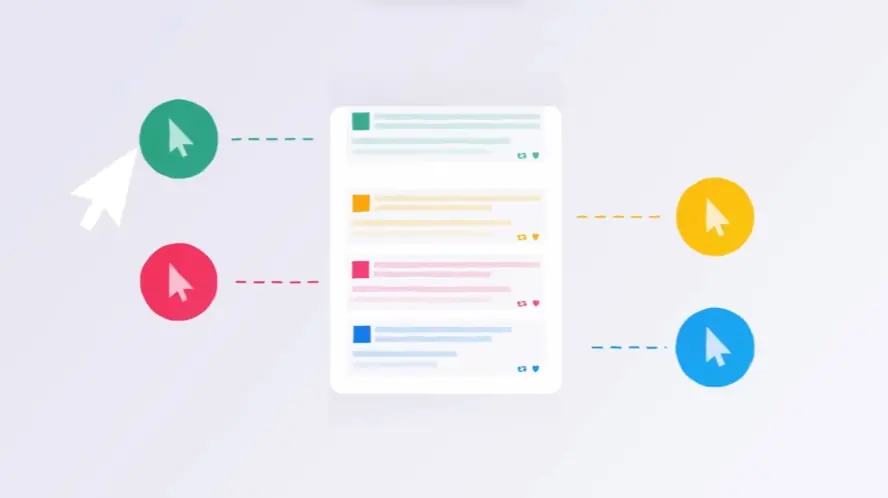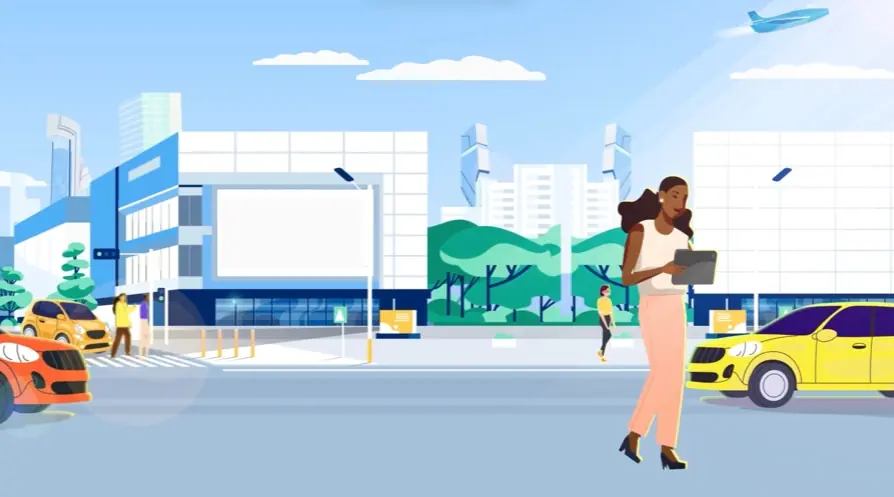We've all seen it – new users opening up something powerful, searching for clarity. Imagine complexity clicking instantly for them? My focus is always on refining that initial journey, ensuring everyone sees the value and capability quickly without getting stuck.
My goal is to make those critical first steps feel intuitive, not overwhelming. That's where truly effective visual guidance makes a difference. Exploring 3D Animation Education Video examples reveals how transforming intricate processes into clear, engaging visuals can accelerate onboarding and build user confidence from moment one.
It’s crucial to plan ahead when it comes to high-quality video production. Discuss with our team, how you can get visual style, budget, timeline in sync.
Jai Ghosh
Video Producer at Advids
Let's talk

How does 3D animation improve understanding of complex scientific concepts in education?
3D animation improves scientific understanding by visualizing dynamic and complex structures like molecular interactions, providing spatial context and depth. It enables interactive simulations for exploration, reduces cognitive load by simplifying concepts, and enhances engagement and retention of abstract principles through compelling visuals.
What are the key benefits of using 3D medical animation for healthcare training?
Key benefits of 3D medical animation include accurate depiction of complex anatomy, physiology, and pathology from multiple angles. It facilitates safe simulation of procedures for practice, visualizes intricate mechanisms like drug actions, and improves comprehension and retention of medical information for trainees and patients alike.
How can technical animation simplify complex machinery and processes for learners?
Technical animation simplifies machinery and processes by showing component interactions and illustrating sequential operations step-by-step, even revealing hidden internal workings. It aids troubleshooting by visualizing potential issues and allows learners to control pace, improving understanding of complex technical concepts and procedures.
How is 3D animation used to create engaging and interactive learning experiences in eLearning?
3D animation creates engaging eLearning by capturing attention and fostering active learning through interactive simulations and virtual environments. It makes complex concepts accessible and memorable with clear visuals, while gamification elements and visual feedback enhance learner motivation and participation in online courses.
What are the applications of 3D animation in corporate training programs?
3D animation is applied in corporate training for engaging onboarding, detailed demonstration of product handling or technical processes, and realistic safety simulations to practice hazardous scenarios safely. It effectively explains complex internal workflows, supply chains, or abstract business concepts to employees and management.
How are simulated medical procedures created and used in training with animation?
Simulated medical procedures are created through meticulous modeling of anatomy and instruments, animating each procedural step in detail. Interactive simulations allow users to perform actions virtually and receive feedback. These are used for safe, repeated practice of complex procedures and training for potential complications.
How can 3D animation be applied in higher education for teaching and research?
In higher education, 3D animation visualizes abstract theories, creates detailed anatomical or geological models, and develops interactive virtual labs for complex or hazardous experiments. It is also used in research for data visualization and modeling, supporting subjects requiring strong spatial understanding like engineering and architecture.
How can 3D animation help visualize abstract concepts in educational content?
3D animation visualizes abstract concepts by creating visual metaphors and representing processes or relationships that lack physical form. It gives structure to theories, making them easier to grasp, improves cognitive understanding of complex systems, and simplifies communication of non-visual information across various academic disciplines.
How does 3D animation contribute to effective safety training in various industries?
3D animation contributes to safety training by simulating hazardous situations without risk, demonstrating proper procedures for equipment or emergencies clearly. It visualizes consequences of errors to reinforce compliance, allows repeated practice of responses, and explains complex safety regulations through engaging and memorable visuals.
How does animation help in visualizing anatomy for medical students?
Animation helps visualize anatomy by providing clear, layered views of structures and showing their dynamic relationships. It visualizes physiological processes linked to anatomy, offers accessible detailed models anytime, and allows interactive exploration, virtual dissection, and self-assessment for enhanced student comprehension.
Defining the visual explanation objective
Creating a 3D Animation Education Video demands more strategizing beyond visualizing concepts; it requires pinpointing precise outcomes for viewers. Successful videos are not simply watched; they motivate specific actions or foster concrete understanding leading to tangible results. Defining this objective clearly from the start guides every creative decision and ensures the final piece serves a genuine purpose.
Achieving measurable impact means specifying desired viewer actions post-video completion. Creators must identify conversion goals tied to these actions, moving past generic prompts towards specific directives like requesting a demonstration or starting a free trial. Evaluating success necessitates determining key metrics beyond simple view counts; this involves quantifying production costs and assigning value to positive outcomes such as reduced support inquiries or accelerated sales cycles for robust ROI measurement.
Content strategy plays a crucial role in meeting objectives. Integrating product or concept demonstrations into realistic, relatable scenarios shows how the subject matter solves actual user problems, illustrating seamless integration into existing workflows. Incorporating social proof elements, perhaps showcasing well-known user logos, quickly builds credibility and viewer trust.
Continuous improvement requires leveraging data. Utilizing analytics helps observe viewer engagement patterns, employing tools like heatmaps to pinpoint watched or skipped sections within the 3D educational animation. Planning A/B tests allows optimizing video components like introductory hooks or calls to action. Adapting the video's length and style based on the platform and audience intent further refines its effectiveness and reach, ensuring the visual explanation aligns perfectly with its intended purpose.
Achieving conceptual depiction through animation
Achieving impactful conceptual depiction through animation involves more than effective structure and comparison. To truly resonate and drive understanding, creators focus on how these visuals translate into measurable outcomes and audience action. They consider the viewer journey and refine the experience based on real interaction.
These strategies are crucial when developing content, particularly for a detailed 3D patient education video explaining a procedure. They ensure the animation not only informs but also prompts necessary next steps or reinforces learning through demonstrated relevance.
- Guiding viewers toward specific actions is paramount. Instead of vague invitations, they employ clear, action-oriented calls to action relevant to the video's purpose. Evaluating the return on investment involves tracking production costs against tangible gains like increased leads or reduced support inquiries, demonstrating the video's business value.
- Making the content relatable significantly boosts engagement. They showcase solutions in real-world contexts, illustrating how features integrate into existing workflows. Analyzing viewer behavior through tools like heatmaps reveals exactly which parts hold attention or cause viewers to drop off, providing data for refinement. Incorporating social proof, such as displaying client logos or user statistics, quickly builds credibility and trust.
- Optimizing the animation for various platforms ensures maximum reach and effectiveness. This means adapting video length and style for different viewing environments. Continuous improvement is achieved through A/B testing, comparing variations in elements like thumbnails or calls to action to identify what resonates best with the target audience. An effective 3D Educational Video applies these layers of strategy.
Implementing these focused techniques helps educational animations achieve their learning objectives and deliver measurable impact.
Showcasing technical demonstration procedures animated visuals
Creating technical demonstration visuals involves more than simply illustrating steps clearly. These animations function as strategic elements, designed to ensure viewers not only understand procedures but also feel moved to action. When developing a 3D animated demonstration video, creators focus on conveying value and prompting specific next steps from their audience.
Achieving impact means linking production costs to measurable outcomes. They track value generated, noting increases in qualified leads or reductions in the sales cycle length because prospects gain better understanding. A decrease in support ticket volume, stemming from users who fully grasped features from the video, also demonstrates a clear return on investment. Showing how the subject integrates into existing workflows and solves problems specific to a user's daily tasks in real-world scenarios significantly boosts perceived value.
Understanding viewer behavior provides crucial insights. Utilizing tools like heatmaps reveals exactly which video segments viewers watch, rewatch, or skip. This granular data helps identify confusing points or areas where interest drops, allowing for targeted refinement. Incorporating social proof, perhaps brief flashes of well-known company logos or statistics about satisfied users, quickly builds credibility and trust. Technical procedures explained through a 3D animated process video benefit greatly from these layers of validation and data-driven improvement.
- Craft calls to action that are specific and action-oriented, moving beyond generic prompts like "Learn More."
- Analyze viewer interaction data to pinpoint confusing segments or moments when engagement declines.
- Conduct A/B testing on various video components, including thumbnails, introductions, and call to action wording.
- Optimize video delivery by considering viewer intent and the viewing environment of different platforms.
Ultimately, approaching technical demonstration visuals with a strategic mindset ensures they effectively educate and convert.
Visualizing complex processes step by step
Visualizing complex processes step by step proves invaluable across many sectors. Whether explaining intricate systems in a 3D architectural video or detailing internal procedures in a 3D corporate video, clarity drives understanding. Beyond simply presenting information, creators guide viewers toward action once understanding dawns. Strong calls action at video completion prove vital, moving beyond generic prompts. They employ specific action verbs: start trial, request demo, download report. Creators tailor these prompts, aligning them video objective where viewer stands journey, ensuring next steps are clear.
Assessing video impact involves measuring Return Investment. They compare production costs against value gained. Value manifests increased qualified leads, shorter sales cycles prospects better informed, reduced support tickets users understood features video. Employing real world scenarios significantly enhance content relevance believability. Demonstrating features within relevant contexts shows how product integrates existing workflows solves problems specific user industry daily tasks, making content relatable.
Analyzing viewer behavior offers deep insight into consumption patterns. Heatmaps attention tracking tools pinpoint exact video parts viewers watching rewatching skipping. This granular data invaluable identifying confusing segments points interest drops, enabling targeted improvements. Incorporating social proof builds immediate credibility trust swiftly. Displaying brief flashes well known company logos using product mentioning statistics number satisfied users reinforces value quickly for new viewers.
- Analyze viewer heatmaps understand engagement duration.
- Track attention points identify confusing sections video.
- Showcase recognizable company logos using product.
- Present statistics number satisfied users or successful outcomes.
A/B testing different video elements key optimization strategy. Testing thumbnails opening ten seconds content CTA placement wording even script variations yields significant insights what resonates most target audience drives higher conversions. Optimizing different platforms requires considering viewer intent viewing environment. Videos social media need grab attention instantly potentially understandable without sound using text overlays shorter format. Videos embedded product pages assume higher viewer intent thus slightly longer detailed presentations are effective. These strategies empower creators refine content maximize educational video impact driving desired outcomes.
Enhancing subject clarity using three dimensional animation
Three-dimensional animation offers unparalleled capability in clarifying complex subjects. Learners gain a deeper understanding by visualizing intricate objects and processes with realistic depth and perspective, revealing internal workings, spatial relationships, and dynamic interactions not possible with static 2D images or basic graphics. This inherent visual strength makes even the most challenging complex subjects immediately more digestible and memorable for viewers striving to grasp detailed material.
Applying this visual power is particularly effective for technical or mechanical topics. Demonstrating the function and operation of elaborate machinery becomes profoundly clear with a detailed 3D equipment animation video that can walk learners through complex sequences step-by-step. Similarly, comprehending complicated systems or large-scale structures within engineering is greatly enhanced by a well-produced 3D engineering video that illustrates flows, components, and environmental context transparently.
Yet, achieving educational goals requires more than just visual fidelity. Truly effective animated videos must strategically guide viewers towards specific, actionable results and incorporate methods to gauge their impact and optimize delivery for the intended audience.
- Calls to action are crucial points for directing viewers these should be explicit contextually relevant and action-oriented moving beyond generic prompts toward specific desired next steps like exploring further resources or engaging with a product
- Evaluating the return on investment involves tracking production costs against tangible benefits generated such as increasing qualified leads reducing the sales cycle length due to better-informed prospects or decreasing support inquiries from users who fully grasped features from the video content
- Using real-world scenarios and relevant contexts makes demonstrations more relatable and increases perceived value while analyzing viewer behavior through sophisticated tools like viewer behavior reveals invaluable data on engagement pinpointing exactly which segments resonate strongly or where interest drops
- Building immediate credibility and trust through incorporating social proof like showcasing recognizable company logos or user statistics complements the core message and continuously refining various elements via A/B testing from thumbnails to script variations or CTA placement ensures the video performs optimally across platforms and audiences
By combining the intrinsic power of three-dimensional visualization with strategic elements focused on guiding the viewer measuring impact and continuous optimization educational animations become potent tools that not only enhance understanding but also drive meaningful engagement and deliver measurable outcomes.
Maximizing learning engagement with animated content
Maximizing learning engagement requires intentional strategy beyond compelling visuals. Crafting calls to action precisely aligns with video objectives, guiding viewers effectively. Action-oriented verbs surpass generic phrasing, clearly signaling next steps. Measuring video impact means connecting production costs directly to value generated. Consider metrics like increased qualified leads, reduced support queries from informed users, or faster sales cycles. Showcasing real-world scenarios makes content relatable, believable. Demonstrating concept or product integration within existing workflows enhances perceived value significantly.
Employing analytics tools provides insight into viewer interaction. Analyzing behavior identifies confusing segments where interest might drop.
- Incorporate social proof elements subtly building credibility. Brief flashes of client logos or user statistics offer powerful validation.
- Utilize A/B testing for continuous improvement. Experimenting with thumbnails, initial content, CTA wording yields valuable insights for higher conversions.
- Optimize content for different platforms, considering viewer intent and environment. Social media demands instant attention, potential for sound-off viewing.
- Tailor the approach; a 3D explainer video walks through concepts step-by-step, while a 3D feature explanation video highlights product benefits powerfully.
Adopting these focused strategies elevates animated educational content from simply informative to genuinely engaging, driving better learning outcomes and demonstrating clear return.
Rendering abstract ideas into tangible visuals
Rendering abstract concepts tangible through visual means is only part of the journey. Strategic thinking ensures these engaging visuals drive concrete outcomes. Success extends beyond presenting clarity; involves guiding viewers toward purposeful next steps. Concluding educational content demands precise calls action. Generic prompts like "Learn More" often fall flat, lacking direction. Stronger engagement stems from action-oriented text. Phrases such as "Start Your Free Trial" or "Download Report" compel specific behaviors. These calls must align perfectly video's objective audience's stage journey.
Measuring video value requires systematic approach tracking production costs against generated benefits. Benefits manifest clearly increased qualified leads. Value also appears reduced sales cycle length, showing prospects better informed. Decreased support volume demonstrates users truly understood features explained. Presenting product function within real-world contexts dramatically increases solution's relatability. Showing how product fits existing workflows, daily tasks boosts perceived value offered. Especially when showing internal processes, complex 3D machinery animation video proves invaluable for viewer comprehension and reduces support queries.
Analyzing viewer behavior interaction patterns offers deep insight audience engagement. Tools like heatmaps attention tracking reveal exact viewing habits viewers. Discover precisely which parts video watched, rewatched, or skipped entirely. This granular data pinpoints confusing segments or points where interest drops significantly. Incorporating social proof quickly builds instant credibility trust. Brief flashes well-known company logos mention satisfied user statistics foster belief product worth. Product tour video benefits significantly incorporating social proof elements early. Optimizing different platforms considers viewer intent viewing environment encountered. Videos social media feeds need instant attention grab, sound optional text overlays, shorter form works best. Video embedded product page assumes higher viewer intent, allows slightly longer, more detailed explanation. Tailoring approach essential for maximizing reach effectiveness, especially specific 3D marketing video campaigns.
- Employ action-oriented calls to action tailored audience and video goals.
- Measure value generated through metrics like lead quality or reduced support volume.
- Show product features within realistic scenarios increase viewer relatability understanding.
- Analyze viewer behavior using tracking tools identify areas improvement optimize content.
Strategic application calls action measurement insights ensures educational 3D animation not only explains effectively but also drives tangible business results demonstrating clear return investment.
Ensuring scientific accuracy within animated models
Ensuring scientific accuracy within animated models involves more than precise visuals. Creators also focus on verifying viewers truly grasp the concepts presented and take desired actions. Effective educational animation translates complex information, but its ultimate value rests on audience engagement and measurable results guiding continuous improvement. Gauging success looks beyond simple view counts, prioritizing tangible business outcomes.
Analyzing audience interaction offers profound insights into content effectiveness. Specialized tools reveal exactly which sections viewers watch intently or choose to skip. This granular understanding complements inherent accuracy, showing if the intended scientific message truly resonates. Applying these analytical approaches helps pinpoint areas where viewers might disengage or require further clarity despite the visual precision.
Incorporating practical context makes complex information more relatable and builds credibility. Showing principles in action or demonstrating how a solution fits existing workflows increases perceived value. Leveraging social proof, such as brief mentions of reputable organizations using the technology or relevant user statistics, quickly builds trust.
- Define clear, action-oriented prompts guiding viewers on the next step.
- Measure value by tracking production costs against outcomes like lead generation or reduced support needs.
- Showcase real-world applications making accurate models relevant and believable.
- Utilize viewer behavior analytics revealing audience engagement patterns within the video.
Testing different elements allows creators to optimize performance continually. A/B testing calls to action or initial sequences helps discern what best motivates the target audience, ensuring scientifically accurate portrayals effectively drive desired results. A well-crafted 3D mechanism video, for instance, detailing complex internal workings, can dramatically reduce follow up questions when viewers fully understand the process. Similarly, a concise 3D medical video explaining a procedure can decrease perceived difficulty and improve patient confidence. These measurement strategies ensure accuracy translates into impactful learning and measurable business value.
Breaking down complex mechanisms visually
Breaking down complex mechanisms visually enables audiences to grasp concepts far beyond what static images or text allow. Teams effectively visualize internal workings, processes, or scale previously hidden, making intricate systems comprehensible. They show how components interact dynamically, revealing the flow and function of complex machinery or abstract ideas step by step.
Incorporating real-world scenarios makes these complex visual explanations relatable. Demonstrating how a mechanism or product integrates into existing workflows or solves specific industry problems increases perceived value. Showing a detailed 3D product demo video can then show the product in action within these contexts, sometimes subtly integrating social proof like glimpses of known client logos to build credibility quickly.
Analyzing viewer behavior offers invaluable insights into how well the visual breakdown is working. Tracking watch duration, rewatch points, and drop-off rates reveals exactly which segments are clear and which might be causing confusion. This granular data directly informs refinements to the visual narrative, ensuring the most critical or complex steps are effectively communicated and understood.
Optimizing for different platforms requires adapting the level of detail and visual style. Content for quick social feeds demands immediate visual grabs and often needs to be understandable without sound, whereas a 3D product animation video embedded on a product page can assume higher viewer intent and thus offer more depth. A/B testing various visual approaches, from the opening sequence to the presentation of key features, helps refine content for maximum impact and understanding across these varied contexts.
- Specific calls to action effectively guide viewers after they understand the visual explanation.
- Reduced support inquiries often demonstrate the clarity achieved through visual breakdown.
- Insights from viewer data pinpoint areas needing visual refinement or emphasis.
- Testing different visual presentations enhances overall comprehension and engagement.
Ultimately, the tangible value of visually breaking down complexity lies in empowering viewers with clear understanding, leading them confidently toward desired actions and outcomes.
Building foundational understanding with simple animations
Building foundational understanding simple animations involves strategic application techniques enhance viewer engagement learning impact. Beyond showing concepts visually, effectiveness hinges video guiding viewer desired actions measuring performance against objectives. Simple animation serves powerful tool explaining complex ideas procedures clearly concisely. They simplify visuals focus essential information reducing cognitive load.
Achieving video goal necessitates clear specific calls action. Generic prompts yield less response action oriented text like start free trial download report proves effective. Tailoring calls action video objective viewer journey stage critical maximizes conversion. Measuring video value tracks production costs generated benefits. Benefits manifest increased qualified leads shorter sales cycles decreased support ticket volume. Tracking these metrics demonstrates concrete return investment production.
Making video relatable uses real world scenarios. Show product integration existing workflows solving user specific problems. This increases perceived value builds credibility. Analyzing viewer behavior reveals exactly where viewers watch rewatch skip. Using heatmaps attention tracking tools provides granular data identifying confusing segments where interest drops. Incorporating social proof brief flashes well known company logos user statistics quickly builds trust. A B testing different elements optimizes viewer resonance conversion. Testing thumbnail first ten seconds CTA placement wording script variations yields significant insight. Optimizing platforms considers viewer intent viewing environment. Videos social media feeds need instant attention often understandable without sound using text overlays shorter. Video embedded product page assumes higher viewer intent allowing more detail.
- Specific calls action drive viewer response better generic prompts.
- Measure video value tracking costs leads cycle length support decrease.
- Viewer behavior analysis identifies engagement points areas confusion viewers skip sections.
- A B testing video elements optimizes viewer resonance conversion rates testing thumbnail CTA variations.
Applying strategic layers enhances simple animation effectiveness across varied contexts. A 3D safety training video benefits immense clarity simple steps. A 3D simulation video explaining equipment operation gains impact relatable scenarios. These techniques ensure animation serves deeper purpose guiding understanding action driving measurable results.
Author & Editor Bio
A video producer with a passion for creating compelling video narratives, Jai Ghosh brings a wealth of experience to his role. His background in Digital Journalism and over 11 years of freelance media consulting inform his approach to video production. For the past 7 years, he has been a vital part of the Advids team, honing his expertise in video content planning, creation, and strategy.
His collaborative approach ensures that he works closely with clients, from startups to enterprises, to understand their communication goals and deliver impactful video solutions. He thrives on transforming ideas into engaging videos, whether it's a product demo, an educational explainer, or a brand story.
An avid reader of modern marketing literature, he keeps his knowledge current. Among his favorite reads from 2024 are "Balls Out Marketing" by Peter Roesler, "Give to Grow" by Mo Bunnell and "For the Culture" by Marcus Collins. His results-driven approach ensures that video content resonates with audiences and helps businesses flourish.





